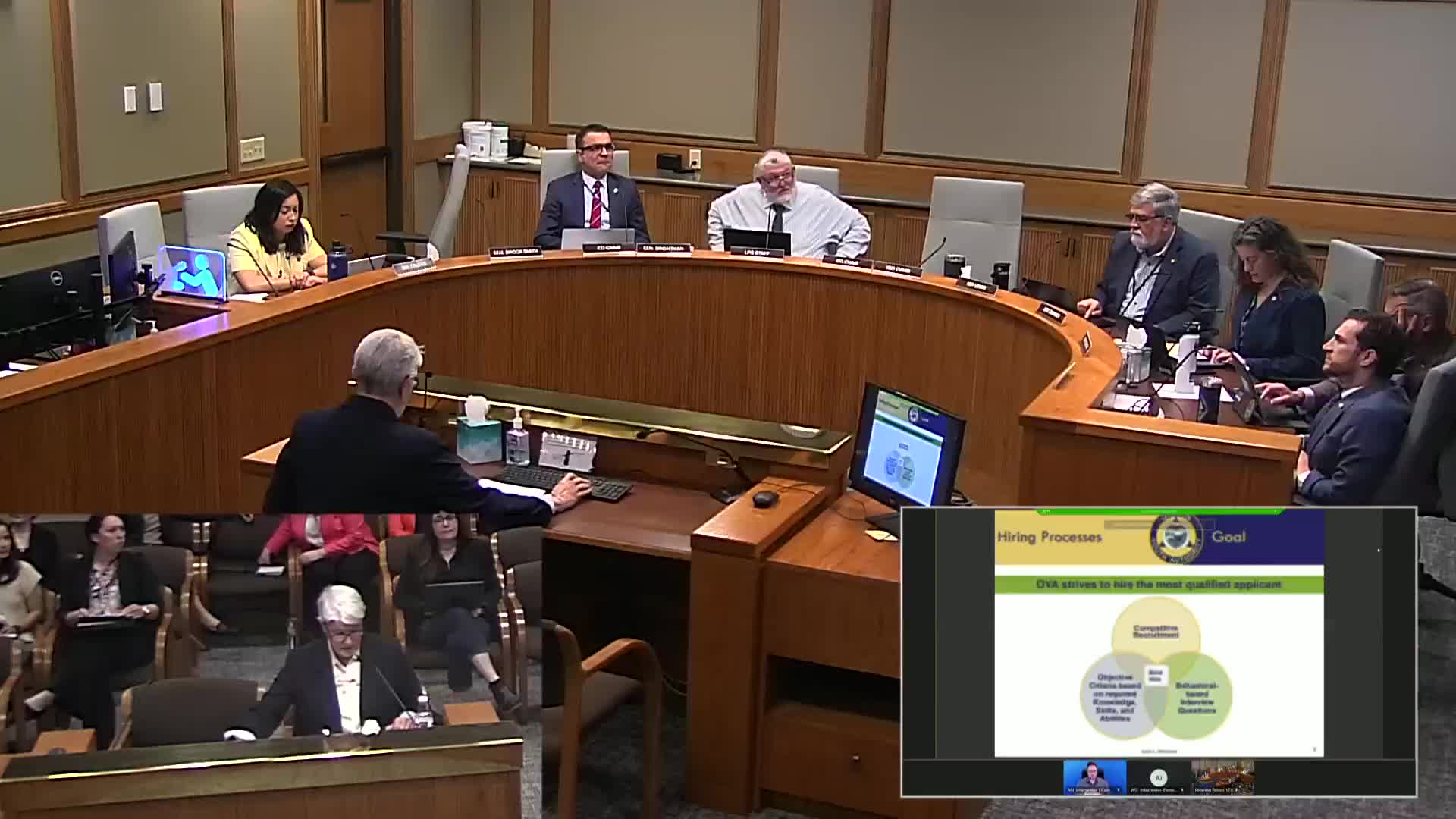OYA says hiring reforms and program mix shape youth population and costs; average stays rising since COVID
May 01, 2025 | Public Safety, Ways and Means, Joint, Committees, Legislative, Oregon
This article was created by AI summarizing key points discussed. AI makes mistakes, so for full details and context, please refer to the video of the full meeting. Please report any errors so we can fix them. Report an error »

Interim Oregon Youth Authority Director Jana McClellan and Assistant Director Sandra Santos told the Public Safety Subcommittee on May 1 that OYA is tightening recruitment timelines, tracking demographic goals for hires, and that population drivers including parole revocations and length of stay are key cost drivers for the agency.
McClellan said the agency will move to a three-week open recruitment period for most positions beginning June 1 to broaden applicant pools and improve hiring outcomes. She emphasized using behavioral-based interview questions to assess candidates' ability to work with high-acuity youth and highlighted the agency's statutory charge to consider demographic disparities between adjudicated youth and staff when hiring.
Population, revocations and length of stay
Assistant Director Sandra Santos outlined how youth typically enter OYA custody: counties refer youth to OYA after exhausting community-based resources, local staffings and court disposition determine commitment, and some youth enter OYA because of parole revocations. Santos said that revocations often follow multiple interventions and supervisory review; on average the agency provides several community interventions before revocation, and revocations are approved by supervisors.
McClellan said on Jan. 1 the agency served 888 youth overall, with 513 in community supervision (probation and parole) and 375 in close-custody facilities. She reported 245 new intakes to facilities in 2024 and 365 new placements in community programs that year, and said about one-third of 2024 facility intakes were parole revocations.
Cost and capacity
McClellan presented per-bed cost figures the agency uses for planning. She said OYA's most expensive community placement is a residential psychiatric treatment setting and the least expensive is foster care. She reported average per-bed costs in close custody and camp settings and noted that Oregon's per-bed figures are near comparator states. The agency also reported a longer average length of stay for some groups and said juvenile commitments' average length of stay increased relative to a prior decade trend.
Why it matters
Longer lengths of stay and higher-intensity placements raise per-youth costs and affect bed availability for unplanned intakes. McClellan told the committee that workforce stabilization is central to supporting youth safety and that high staff turnover and mandatory overtime can exacerbate staffing shortages.
Ending
Lawmakers asked follow-up questions about certification and record-sharing when employees resign in lieu of termination; agency leaders said they would follow up with details. McClellan and Santos said they would continue to provide data to the committee and that recruitment and workforce-stabilization efforts are ongoing.
McClellan said the agency will move to a three-week open recruitment period for most positions beginning June 1 to broaden applicant pools and improve hiring outcomes. She emphasized using behavioral-based interview questions to assess candidates' ability to work with high-acuity youth and highlighted the agency's statutory charge to consider demographic disparities between adjudicated youth and staff when hiring.
Population, revocations and length of stay
Assistant Director Sandra Santos outlined how youth typically enter OYA custody: counties refer youth to OYA after exhausting community-based resources, local staffings and court disposition determine commitment, and some youth enter OYA because of parole revocations. Santos said that revocations often follow multiple interventions and supervisory review; on average the agency provides several community interventions before revocation, and revocations are approved by supervisors.
McClellan said on Jan. 1 the agency served 888 youth overall, with 513 in community supervision (probation and parole) and 375 in close-custody facilities. She reported 245 new intakes to facilities in 2024 and 365 new placements in community programs that year, and said about one-third of 2024 facility intakes were parole revocations.
Cost and capacity
McClellan presented per-bed cost figures the agency uses for planning. She said OYA's most expensive community placement is a residential psychiatric treatment setting and the least expensive is foster care. She reported average per-bed costs in close custody and camp settings and noted that Oregon's per-bed figures are near comparator states. The agency also reported a longer average length of stay for some groups and said juvenile commitments' average length of stay increased relative to a prior decade trend.
Why it matters
Longer lengths of stay and higher-intensity placements raise per-youth costs and affect bed availability for unplanned intakes. McClellan told the committee that workforce stabilization is central to supporting youth safety and that high staff turnover and mandatory overtime can exacerbate staffing shortages.
Ending
Lawmakers asked follow-up questions about certification and record-sharing when employees resign in lieu of termination; agency leaders said they would follow up with details. McClellan and Santos said they would continue to provide data to the committee and that recruitment and workforce-stabilization efforts are ongoing.
View full meeting
This article is based on a recent meeting—watch the full video and explore the complete transcript for deeper insights into the discussion.
View full meeting
